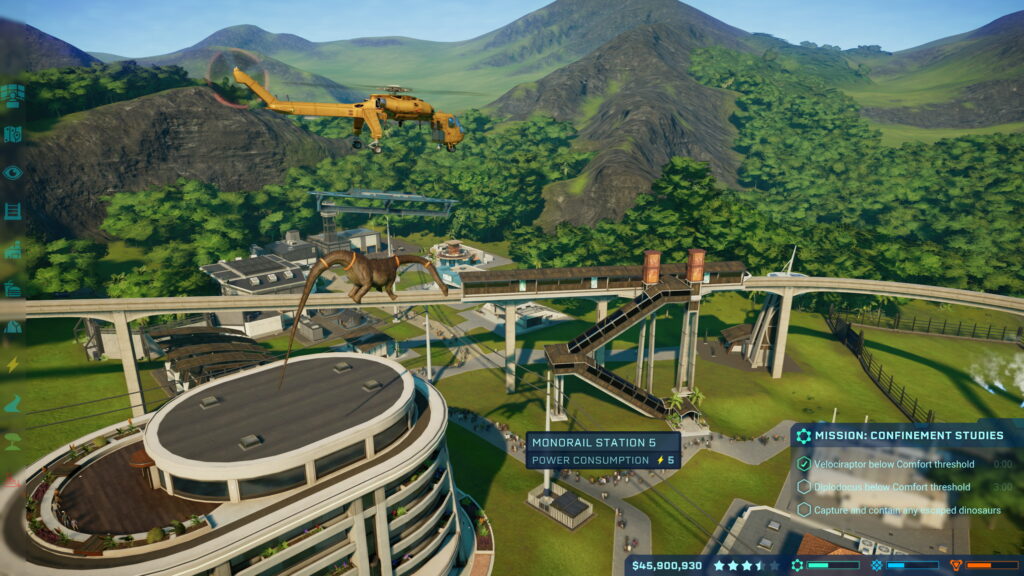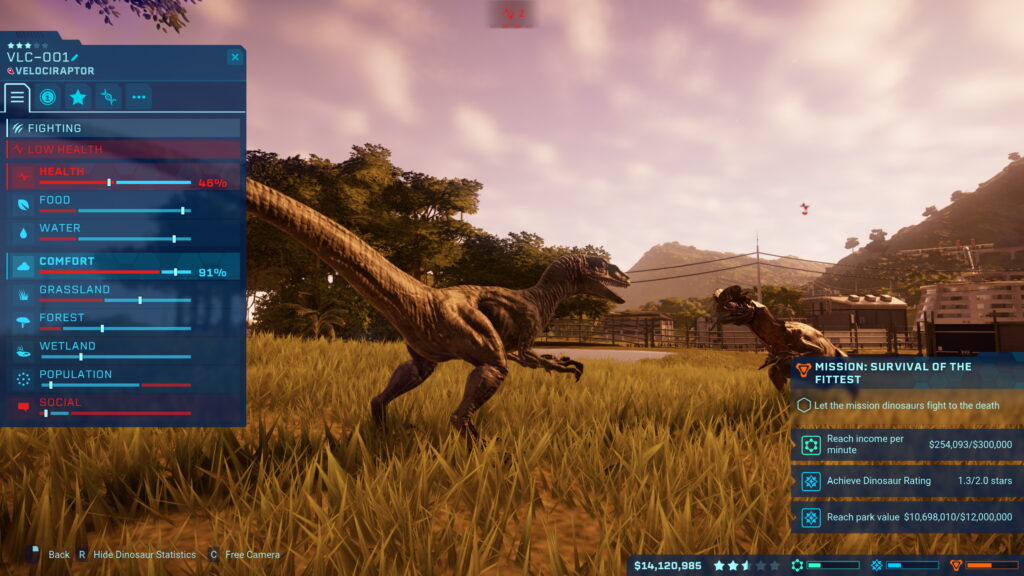
This was a free game on the Epic platform not too long ago and of course it’s only just about now that the sequel dropped. I played this because I really liked Frontier Development’s Planet Coaster and wanted to see what they could do with the Jurassic Park property. Plus of course it was free. Having done so, I have to say that while the game has its merits and it’s rather fun just to watch dinosaurs for a while this is a really shallow game and it leaves me with no desire to play the sequel. In fact, I’ve taken Planet Zoo off of my wishlist because I fear it will be too similar. Ouch!
Here you have to build and manage a dinosaur theme park, actually a series of five of them, one on each island, as part of the main campaign. You have all the expected buildings: fenced enclosures for the dinosaurs, power generators and power lines, viewing galleries, shops for the tourists, paths to connect them all together etc. But you also have plenty of stuff specific to this game. To actually make dinosaurs you need enough of the DNA of each species. This starts with sending out expeditions to collect fossils, processing what you find to extract DNA and then using it to incubate eggs. Naturally there are buildings for all of that work. Then you need rangers to do work like repairing broken fences, healing sick dinosaurs and replenishing their food. You also need helicopters to hunt down escaped dinosaurs to tranquilize them from the air and them transport them to where they are supposed to be. Finally you need to do research to get building upgrades and unlock genetic engineering options. Pretty soon the limited land areas in your park will be crammed with all these support buildings.

The true heart of the game is still where it should be: hatching dinosaurs and releasing them into enclosures that are appropriate for them. Different species have different requirements in terms of the area of grassland, forest and wetland terrain that they prefer. There are also limits to how many you can fit in an enclosure and you surely know what happens when you put carnivores and herbivores in the same space. Perhaps more troublesome is that some species are social creatures, meaning that they will only be happy if there is a group of them together. While building the enclosures, you’ll also have to ensure that tourists can actually view the dinosaurs and that park rangers can readily access them in an emergency. Figuring out an effective layout for everything is probably the main challenge in the game given the very tight spaces of most of the maps.
Naturally this wouldn’t be Jurassic Park without emergencies and this game really likes to keep you on your toes. Except for the beginning ones, all islands are beset by storms which can damage your buildings. You can build storm defense stations to reduce the damage but you can’t eliminate the damage entirely. Later on, storms come with tornados that absolutely will destroy anything it passes over. This means the power gets cut, fences are broken open and dinosaurs get upset and run rampant all over your park. When your ranger station is inoperative, you actually have to manually drive your jeep around to fix things. Even when there aren’t any storms, dinosaurs will bash their heads against the walls of their enclosures and escape when they get upset. Stronger walls simply keep them in longer but any wall can eventually be broken through. Better hope that your visitors are safely in their shelters when this happens. Note that unlike most such games, you can’t pause the game. Part of the challenge is responding to these emergencies in real time.

This inability to pause nearby gave me a heart attack when I first started playing because your park starts bleeding cash every minute before you get things set up and I normally like to spend some time carefully thinking through the park layout. But it turns out that the business simulation side of the game is very forgiving. You only need a few dinosaurs to start turning a profit and very quickly you’ll be rolling in more money than you know what to do with. Once you understand the mechanics, the whole game is generally really easy as well. All dinosaurs have a rating which determines how exciting visitors find them and by focusing only on these you can get a park with a very high rating with a surprisingly low number of dinosaurs. Of course you still need to be careful. Velociraptors for example are too much trouble to be worth it despite their relatively high rating because they act out so easily. They’ll start attacking the fences the moment they feel the slightest bit uncomfortable and they are social creatures so they get upset if one is by itself. It’s almost always a better idea to opt for more docile dinosaurs.
The main campaign consists of performing missions for the three divisions of the company: science, entertainment and security. You also need to perform repeatable, randomly generated contracts to raise your reputation with each of them first. This provides some direction for the gameplay beyond just building the park like a sandbox. While the missions aren’t very difficult, they can be annoying and sometimes outright evil. For example, they might ask you to create two specific types of dinosaurs and allow them to fight until one kills the other. The security division missions frequently require you to create extremely dangerous dinosaurs up to and including the fictional Indominus Rex hybrid which are scripted to always be upset no matter what you do and so keeps trying to escape. It’s a pain to deal with especially if you get hit by a storm at the same time. But you can always keep the park closed while working on these missions as by then you should have so much money that income doesn’t matter any longer. Even if a dinosaur kills some guests, it’s actually not that big a deal.

Anyway there’s some satisfaction to seeing dinosaurs come out of your labs and there are so many species that I doubt most people are going to collect all of the genomes and make all of them. The dinosaurs also have some depth to their behaviors and it can interesting to experiment with their interactions. For example, the long-necked herbivores are all so big that only the very largest carnivores can attack them so they can be safely kept in the same enclosures with small and medium-sized carnivores. Similarly medium-sized carnivores of different species will fight and kill one another and so will small-sized carnivores. But small carnivores will run away from medium ones so they can actually be kept together as well. Usually however they just roam around, eat and sleep so it’s not like it’s entertaining to watch them for very long.
Similarly there is some challenge to fitting all of the required buildings and enclosures within the maps you’re given, but there’s very little scope for deep customization in this game. There are very few scenery items and the park simulation mechanics are very simplified. There’s no real way or need to tweak a park to look exceptional. One park will look much the same as another, unlike Planet Coaster which really allowed creators to go wild with their imagination. This is why I say that this is a shallow game with very little staying power. I guess Frontier Development deliberately targeted this towards a wider audience. I understand that Planet Zoo has far more complex mechanics than this but I find that I don’t relish the thought of having to micromanage the day-to-day problems of large numbers of animals either, making sure they’re well-fed, clean, healthy, happy etc. Playing this once has been enough to satisfy my curiosity so thanks for the free game I suppose!
